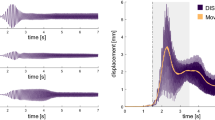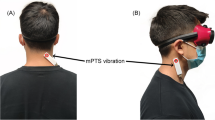Abstract
Whole body vibration (WBV) may enhance muscular strength and power but little is known about its influence on sensory-motor function. Vibration of a single muscle or tendon affects the afferent system in a manner that depends on amplitude and frequency. WBV stimulates many muscle groups simultaneously and the frequencies and amplitudes used are different from many of the studies on single musculotendinous units. We investigated the effects of WBV at two amplitudes on balance, joint position sense (JPS) and cutaneous sensation in young healthy subjects. Eighteen adults (24.3 ± 1.5 years, 15 females) were assessed before WBV (five 1 min bouts, 30 Hz) then immediately, 15 and 30 min afterwards. Two amplitudes (4 and 8 mm peak to peak) were investigated on different occasions. Standing balance was assessed with feet together and eyes closed, and standing on one leg with eyes open and closed. JPS at the knee and ankle was assessed by repositioning tasks while cutaneous sensation was recorded from six sites in the lower limb using pressure aesthesiometry. Neither amplitude affected JPS (P > 0.05). There were minimal effects on balance only in the vertical plane and only 30 min after WBV (P < 0.05). Low amplitude vibration only reduced sensation at the foot and ankle immediately after WBV (P < 0.008). High amplitude vibration impaired sensation at the foot, ankle and posterior shank for the entire test period (P < 0.008). In young healthy individuals WBV did not affect JPS or static balance, but reduced cutaneous sensation. These data may have implications for older and clinical populations with compromised postural control.


Similar content being viewed by others
References
Bell JA (1978) Sensibility evaluation. In: Hunter JM (ed) Rehabilitation of the hand. Mosby, St Louis, p 273
Bensmaïa SJ, Leung YY, Hsiao SS, Johnson KO (2005) Vibratory adaptation of cutaneous mechanoreceptive afferents. J Neurophysiol 94(5):3023–3036. doi:10.1152/jn.00002.2005
Bianconi R, Van Der Meulen JP (1963) The response to vibration of the end organs of mammalian muscle spindles. J Neurophysiol 26(1):177–190
Bloem BR, Allum JHJ, Carpenter MG, Honegger F (2000) Is lower leg proprioception essential for triggering human automatic postural responses? Exp Brain Res 130(3):375–391
Bogaerts A, Verschueren S, Delecluse C, Claessens AL, Boonen S (2007) Effects of whole body vibration training on postural control in older individuals: a 1 year randomized controlled trial. Gait Posture 26(2):309–316
Brown MC, Engberg I, Matthews PBC (1967) The relative sensitivity to vibration of muscle receptors of the cat. J Physiol 192(3):773–800
Bruyere O, Wuidart MA, Di Palma E, Gourlay M, Ethgen O, Richy F, Reginster JY (2005) Controlled whole body vibration to decrease fall risk and improve health-related quality of life of nursing home residents. Arch Phys Med Rehabil 86(2):303–307
Burke D, Hagbarth KE, Lofstedt L, Wallin BG (1976) The responses of human muscle spindle endings to vibration of non-contracting muscles. J Physiol 261(3):673–693
Capraro AJ, Verrillo RT, Zwislocki JJ (1979) Psychophysical evidence for a triplex system of cutaneous mechanoreception. Sens Process 3(4):334–352
Cardinale M, Bosco C (2003) The use of vibration as an exercise intervention. Exerc Sport Sci Rev 31(1):3–7
Cardinale M, Lim J (2003) The acute effects of two different whole body vibration frequencies on vertical jump performance. Med Sport (Roma) 56(4):287–292
Cochrane DJ, Stannard SR (2005) Acute whole body vibration training increases vertical jump and flexibility performance in elite female field hockey players. Br J Sports Med 39(11):860–865
Diener HC, Dichgans J, Guschlbauer B, Mau H (1984) The significance of proprioception on postural stabilization as assessed by ischemia. Brain Res 296(1):103–109
Fitzpatrick RC, Gorman RB, Burke D, Gandevia SC (1992) Postural proprioceptive reflexes in standing human subjects: bandwidth of response and transmission characteristics. J Physiol 458:69–83
Fontana TL, Richardson CA, Stanton WR (2005) The effect of weight-bearing exercise with low frequency, whole body vibration on lumbosacral proprioception: a pilot study on normal subjects. Aust J Physiother 51(4):259–263
Furness TP, Maschette WE (2009) Influence of whole body vibration platform frequency on neuromuscular performance of community-dwelling older adults. J Strength Cond Res 23(5):1508–1513
Harrington GS, Hunter Downs III J (2001) Fmri mapping of the somatosensory cortex with vibratory stimuli: Is there a dependency on stimulus frequency? Brain Res 897(1–2):188–192
Hollins M, Roy EA (1996) Perceived intensity of vibrotactile stimuli: the role of mechanoreceptive channels. Somatosens Mot Res 13(3):273–286
Imai H, Tajima T, Natsuma Y (1989) Interpretation of cutaneous pressure threshold (semmes-weinstein monofilament measurement) following median nerve repair and sensory reeducation in the adult. Microsurgery 10(2):142–144
Ishihara Y, Izumizaki M, Atsumi T, Homma I (2004) Aftereffects of mechanical vibration and muscle contraction on limb position-sense. Muscle Nerve 30(4):486–492
Jonsson E, Seiger Å, Hirschfeld H (2004) One-leg stance in healthy young and elderly adults: a measure of postural steadiness? Clin Biomech 19(7):688–694
Kasai T, Kawanishi M, Yahagi S (1992) The effects of wrist muscle vibration on human voluntary elbow flexion-extension movements. Exp Brain Res 90(1):217–220
Kavounoudias A, Roll R, Roll J-P (1998) The plantar sole is a ‘dynamometric map’ for human balance control. Neuroreport 9(14):3247–3252
Leung YY, Bensmaia SJ, Hsiao SS, Johnson KO (2005) Time-course of vibratory adaptation and recovery in cutaneous mechanoreceptive afferents. J Neurophysiol 94(5):3037–3045. doi:10.1152/jn.00001.2005
Li L, Lamis F, Wilson SE (2008) Whole-body vibration alters proprioception in the trunk. Int J Ind Ergon 38(9–10):792–800
Lundstrom RJ (1986) Responses of mechanoreceptive afferent units in the glabrous skin of the human hand to vibration. Scand J Work Environ Health 12(4 Spec No):413–416
Magnusson M, Enbom H, Johansson R, Pyykko I (1990) Significance of pressor input from the human feet in anterior-posterior postural control. The effect of hypothermia on vibration-induced body-sway. Acta Otolaryngol 110(3-4):182–188
Martin B, Gauthier GM, Roll JP, Hugon M, Harlay F (1980) Effects of whole-body vibrations on standing posture in man. Aviat Space Environ Med 51(8):778–787
McGrath GJ, Matthews PBC (1973) Evidence from the use of vibration during procaine nerve block that the spindle group ii fibres contribute excitation to the tonic stretch reflex of the decerebrate cat. J Physiol 235(2):371–408
Moezy A, Olyaei G, Hadian M, Razi M, Faghihzadeh S (2008) A comparative study of whole body vibration training and conventional training on knee proprioception and postural stability after anterior cruciate ligament reconstruction. Br J Sports Med 42(5):373–378
Perry SD, McIlroy WE, Maki BE (2000) The role of plantar cutaneous mechanoreceptors in the control of compensatory stepping reactions evoked by unpredictable, multi-directional perturbation. Brain Res 877(2):401–406
Pollock RD, Woledge RC, Mills KR, Martin FC, Newham DJ (2010) Muscle activity and acceleration during whole body vibration: effect of frequency and amplitude. Clin Biomech 25(8):840–846
Ribot-Ciscar E, Vedel JP, Roll JP (1989) Vibration sensitivity of slowly and rapidly adapting cutaneous mechanoreceptors in the human foot and leg. Neurosci Lett 104(1–2):130–135
Rittweger J (2010) Vibration as an exercise modality: how it may work, and what its potential might be. Eur J Appl Physiol 108:877–904
Rittweger J, Beller G, Felsenberg D (2000) Acute physiological effects of exhaustive whole-body vibration exercise in man. Clin Physiol 20(2):134–142
Roll JP, Vedel JP (1982) Kinaesthetic role of muscle afferents in man, studied by tendon vibration and microneurography. Exp Brain Res 47(2):177–190
Roll JP, Vedel JP, Ribot E (1989) Alteration of proprioceptive messages induced by tendon vibration in man: a microneurographic study. Exp Brain Res 76(1):213–222
Roll RCA, Kavounoudias A, Roll J-P (2002) Cutaneous afferents from human plantar sole contribute to body posture awareness. Neuroreport 13(15):1957–1961
Schmidt RF (1986) Fundamentals of sensory physiology; third, revised and expanded. Springer, New York
Talbot WH, Darian-Smith I, Kornhuber HH, Mountcastle VB (1968) The sense of flutter-vibration: comparison of the human capacity with response patterns of mechanoreceptive afferents from the monkey hand. J Neurophysiol 31(2):301–334
Toma S, Nakajima Y (1995) Response characteristics of cutaneous mechanoreceptors to vibratory stimuli in human glabrous skin. Neurosci Lett 195(1):61–63
Torvinen S, Kannus P, Sievanen H, Jarvinen TAH, Pasanen M, Kontulainen S, Jarvinen TLN, Jarvinen M, Oja P, Vuori I (2002a) Effect of a vibration exposure on muscular performance and body balance. Randomized cross-over study. Clin Physiol Funct Imaging 22(2):145–152
Torvinen S, Kannus P, Sievanen H, Jarvinen TAH, Pasanen M, Kontulainen S, Jarvinen TLN, Jarvinen M, Oja P, Vuori I (2002b) Effect of four-month vertical whole body vibration on performance and balance. Med Sci Sports Exerc 34(9):1523–1528
Torvinen S, Sievanen H, Jarvinen TAH, Pasanen M, Kontulainen S, Kannus P (2002c) Effect of 4-min vertical whole body vibration on muscle performance and body balance: a randomized cross-over study. Int J Sports Med 23(5):374–379
Torvinen S, Kannus P, Sievanen H, Jarvinen TAH, Pasanen M, Kontulainen S, Nenonen A, Jarvinen TLN, Paakkala T, Jarvinen M, Vuori I (2003) Effect of 8-month vertical whole body vibration on bone, muscle performance, and body balance: a randomized controlled study. J Bone Miner Res 18(5):876–884
Trans T, Aaboe J, Henriksen M, Christensen R, Bliddal H, Lund H (2009) Effect of whole body vibration exercise on muscle strength and proprioception in females with knee osteoarthritis. Knee 16(4):256–261
Vallbo AB, Johansson RS (1984) Properties of cutaneous mechanoreceptors in the human hand related to touch sensation. Hum Neurobiol 3(1):3–14
van Nes IJW, Geurts ACH, Hendricks HT, Duysens J (2004) Short-term effects of whole-body vibration on postural control in unilateral chronic stroke patients: preliminary evidence. Am J Phys Med Rehabil 83(11):867–873
Vedel JP, Roll JP (1982) Response to pressure and vibration of slowly adapting cutaneous mechanoreceptors in the human foot. Neurosci Lett 34(3):289–294
Wang T-Y, Lin S-I (2008) Sensitivity of plantar cutaneous sensation and postural stability. Clin Biomech 23(4):493–499
Weerakkody NS, Mahns DA, Taylor JL, Gandevia SC (2007) Impairment of human proprioception by high-frequency cutaneous vibration. J Physiol 581(Pt 3):971–980
Wierzbicka MM, Gilhodes JC, Roll JP (1998) Vibration-induced postural posteffects. J Neurophysiol 79(1):143–150
Acknowledgments
We are grateful for funding from Research into Ageing. We would like to thank all participants and thank Tony Christopher and Lyndsey Marjoram for their technical assistance.
Conflict of interest
None.
Author information
Authors and Affiliations
Corresponding author
Additional information
Communicated by Fausto Baldissera.
Rights and permissions
About this article
Cite this article
Pollock, R.D., Provan, S., Martin, F.C. et al. The effects of whole body vibration on balance, joint position sense and cutaneous sensation. Eur J Appl Physiol 111, 3069–3077 (2011). https://doi.org/10.1007/s00421-011-1943-y
Received:
Accepted:
Published:
Issue Date:
DOI: https://doi.org/10.1007/s00421-011-1943-y




